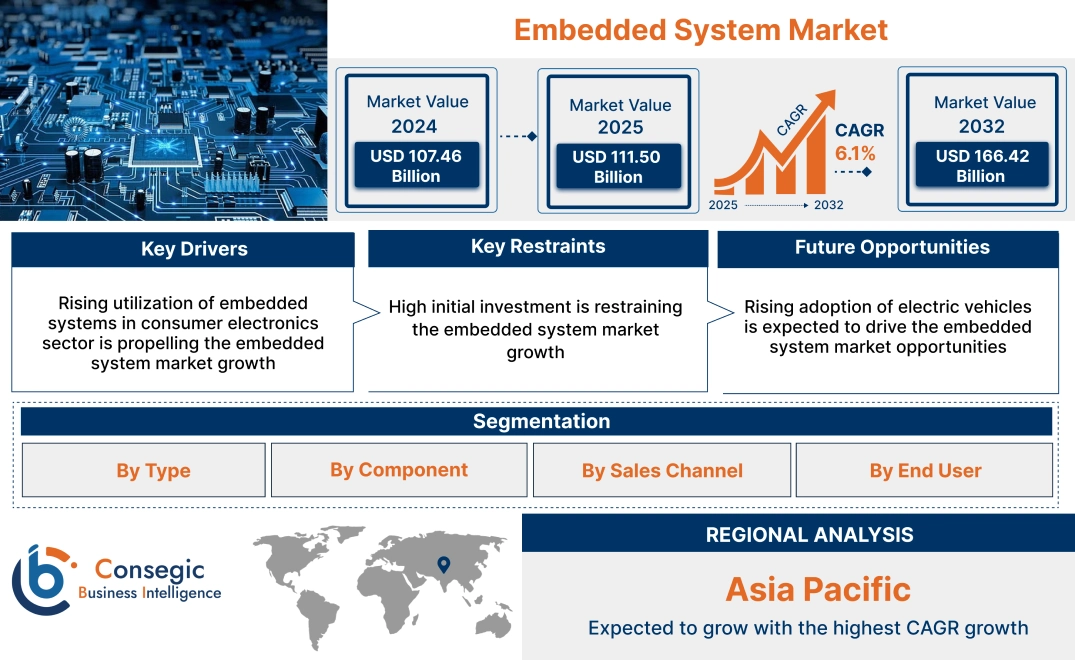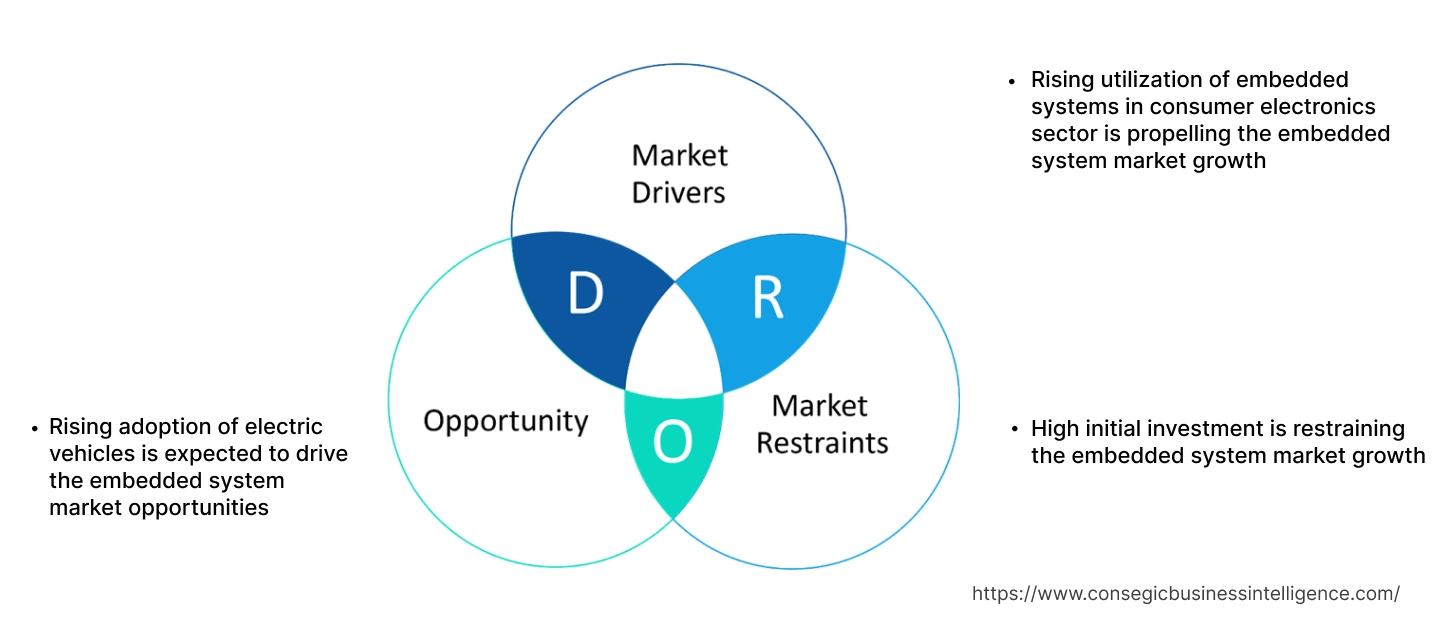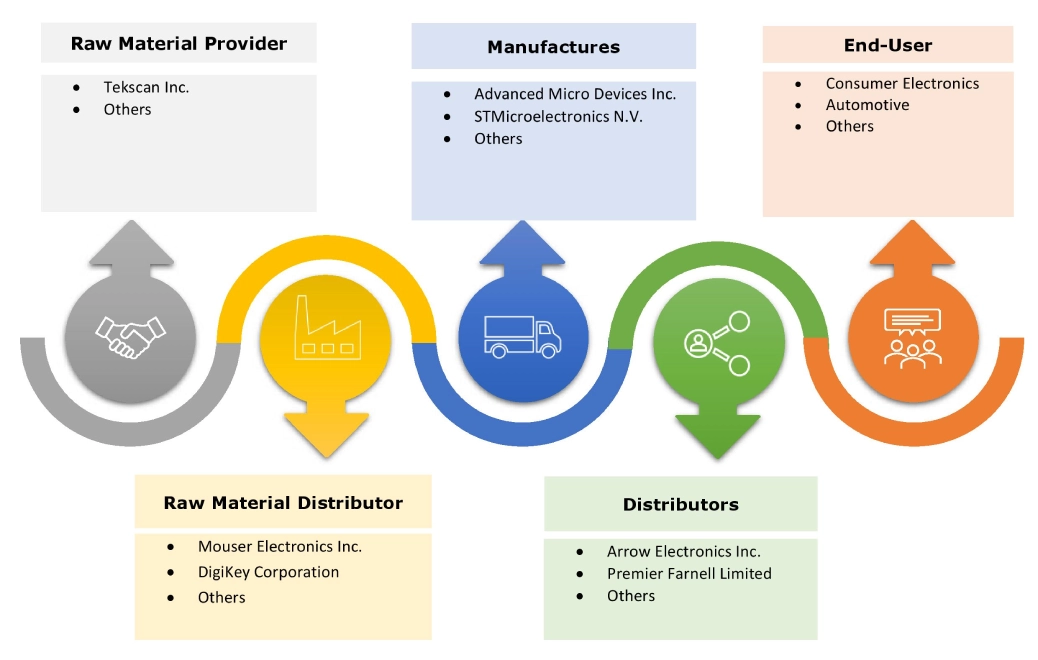- Summary
- Table Of Content
- Methodology
Embedded System Market Size:
Embedded System Market size is estimated to reach over USD 166.42 Billion by 2032 from a value of USD 107.46 Billion in 2024 and is projected to grow by USD 111.50 Billion in 2025, growing at a CAGR of 6.1% from 2025 to 2032.
Embedded System Market Scope & Overview:
Embedded system (ES) refers to a combination of computer hardware and software that is designed for performing a specific function. Moreover, ES provide a range of benefits such as compact design, real-time performance, improved operational efficiency, reliability, ease of customization, cost-efficiency, and others. The aforementioned benefits are further driving its adoption in consumer electronics, automotive, healthcare, aerospace & defense, telecommunication, and other industries.
Key Drivers:
Rising utilization of embedded systems in consumer electronics sector is propelling the embedded system market growth
Embedded systems are primarily used in consumer electronics sector for application in smartphones, tablets, smart TVs, wearable devices, home appliances, and other consumer devices. Moreover, ES plays a vital role in consumer electronics sector, enabling a broad range of consumer devices to perform specific functions efficiently and effectively. The integration of embedded solutions in consumer electronics sector offers a range of benefits such as enhanced functionality, increasing efficiency, and connectivity across a wide range of consumer devices.
- For instance, according to India Brand Equity Foundation (IBEF), smartphone production witnessed a substantial growth in India, wherein the smartphone sector was valued at USD 49.55 billion in FY2023-24.
Hence, the rising production of consumer electronics devices is driving the adoption of embedded solutions for application in smartphones, tablets, smart TVs, wearable devices, and other consumer devices, in turn proliferating the embedded system market size.
Key Restraints:
High initial investment is restraining the embedded system market growth
High initial investment associated with manufacturing embedded systems is among the primary factors restraining the market. The upfront costs associated with manufacturing embedded systems including costs of equipment, hardware, software, and others along with integrating them into existing systems can be significantly high, which may cause financial barriers, particularly for smaller businesses or businesses operating on tighter budgets.
Additionally, embedded devices can be quite complex to install and integrate, which further necessitates additional expenses on training personnel or hiring specialized experts for integrating the systems effectively. Therefore, high initial investments associated with manufacturing embedded devices are hindering the embedded system market expansion.
Future Opportunities :
Rising adoption of electric vehicles is expected to drive the embedded system market opportunities
Embedded devices are primarily used in automotive sector for applications involving advanced driver assistance systems (ADAS), airbag control systems, infotainment systems, navigation and communication systems, and others. Embedded devices play a crucial role in enhancing vehicle performance, safety, and connectivity. Modern automobiles, particularly electric vehicles, commonly consist of several embedded devices that are designed to perform different tasks within the vehicle.
- For instance, according to the International Energy Agency (IEA), the total registration of electric cars worldwide reached approximately 13.8 million units in 2023, among which BEV (battery electric vehicles) accounted for 9.5 million and PHEV (plug-in hybrid electric vehicle) accounted for 4.3 million respectively.
Thus, the rising adoption of electric vehicles is projected to drive the embedded system market opportunities during the forecast period.
Embedded System Market Segmental Analysis :
By Type:
Based on type, the market is segmented into standalone embedded system, real-time embedded system, network embedded system, and mobile embedded system.
Trends in the type:
- Rising adoption of standalone embedded devices due to its independent operations, reliability, faster operation, cost efficiency, and others.
- Increasing trend towards utilization of real-time embedded devices in time-sensitive sectors such as manufacturing, transportation, and healthcare among others.
Standalone embedded system segment accounted for the largest revenue share of 35.45% in the overall market in 2024.
- Standalone systems are capable of working by itself without any requirement of a host such as a computer or processor.
- Standalone system works by taking input data in its analog or digital form and delivering an output that can be displayed through a connected device. Examples of standalone embedded devices include cameras, watches, home appliances, and others.
- Moreover, standalone embedded devices provide several benefits including independent operations, reliability, faster operation, cost efficiency, and others.
- For instance, in February 2023, Panasonic Corporation launched its new hybrid full-frame mirrorless digital camera, LUMIX S5II in the Indian market. The new newly launched digital camera is integrated with a new phase hybrid auto-focus along with a powerful image stabilization system. The camera offers excellent video/photo performance and superior portability to content creators.
- Thus, increasing advancements associated with standalone embedded devices are accelerating the embedded system market size.
Real-time embedded system segment is anticipated to register fastest CAGR growth during the forecast period.
- Real-time embedded device refers to a system that processes data and responds within a strict time constraint.
- Real-time embedded devices are designed to ensure timely execution of tasks, often in response to external events or inputs.
- Moreover, real-time embedded devices are primarily used in time-sensitive sectors such as manufacturing, transportation, and healthcare among others.
- For instance, according to the International Organization of Motor Vehicle Manufacturers, the total production of passenger cars worldwide reached o 68,020,265 units in 2023, witnessing an incline of nearly 11% from 61,553,361 units in 2022.
- Thus, the rising automotive production is projected to increase the demand for real-time embedded devices for application in automobile electronics systems, in turn driving the market during the forecast period.
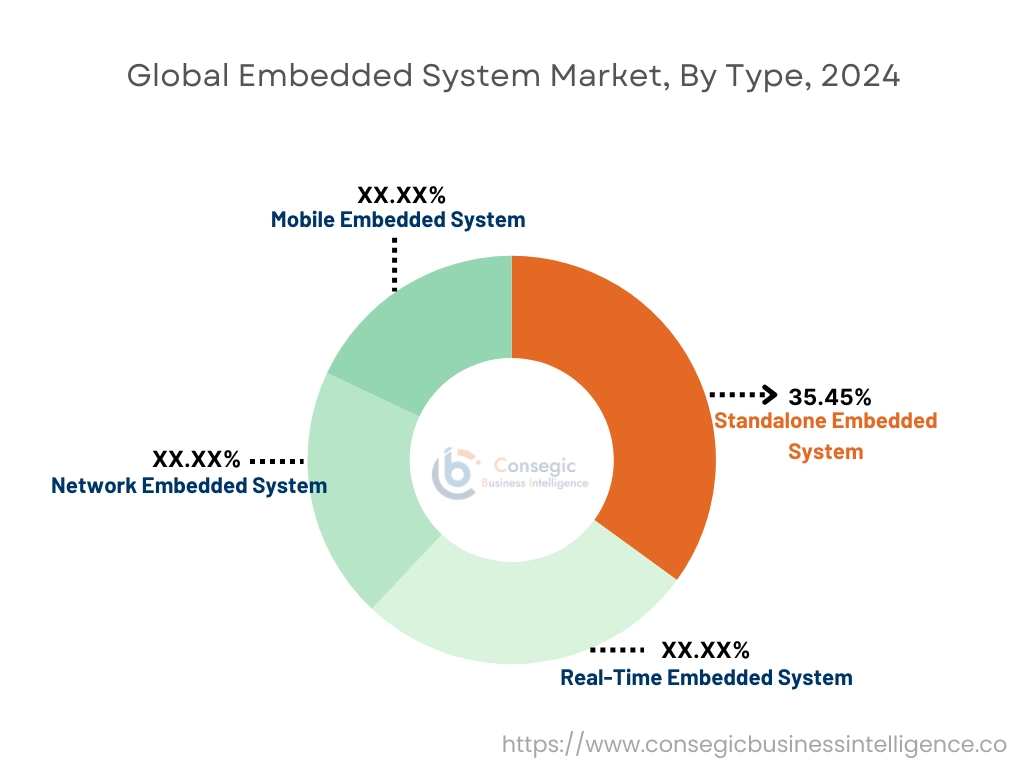
By Component:
Based on component, the market is segmented into hardware and software.
Trends in the component:
- Increasing technological advancements associated with embedded device hardware components such as microcontroller (MCU), memory, sensors, and others.
- There is a rising trend towards utilization of embedded software, attributing to its benefits such as improved resource optimization, ease of customization, real-time performance, increased scalability, and others.
Hardware segment accounted for the largest revenue share in the total embedded system market in 2024.
- The primary hardware components used in embedded solutions include microcontroller (MCU) or microprocessor, memory, sensors, actuators, communication interfaces, and others.
- Moreover, microcontrollers or microprocessors are responsible for executing instructions and processing data. Sensors are used for gathering data from the environment and converting it into signals for the embedded device.
- Meanwhile, actuators are responsible for performing actions based on the system's control outputs. Additionally, communication interfaces facilitate communication between embedded devices and other systems or networks.
- For instance, in November 2024, Infineon Technologies AG launched its new AURIX TC4Dx model of microcontroller. The microcontroller offers improved performance and high-speed connectivity.
- According to the embedded system market analysis, the rising innovations associated with hardware components used in embedded devices are driving the market.
Software segment is anticipated to register fastest CAGR growth during the forecast period.
- Embedded software refers to a set of programs or code are responsible for instructing the embedded hardware components on how to perform specific tasks.
- Embedded software usually includes both the firmware that directly controls the hardware along with higher-level application software.
- Moreover, embedded software offers a range of benefits such as improved resource optimization, real-time performance, ease of customization, increased scalability, and others.
- For instance, Advanced Micro Devices Inc. launched its new embedded system software version 2024.2, integrated with upgraded features including bootloader & firmware, AI engine device drivers, stand-alone libraries, and others.
- According to the analysis, increasing advancements related to embedded software are anticipated to propel the embedded system market trends during the forecast period.
By Sales Channel:
Based on sales channel, the market is segmented into direct sales and distributor sales.
Trends in the sales channel:
- Factors including the availability of excellent support and warranty, higher product quality, and reliable shipping and return policies are key prospects driving the direct sales channel segment.
- Factors such as higher accessibility to a variety of products, higher flexibility, and expanded reach are major determinants for driving the distributor sales channel segment.
Direct sales channel segment accounted for a significant revenue in the overall embedded system market share in 2024.
- In direct sales channel, embedded devices are available for direct sale to customers through several physical outlets such as company outlets.
- Moreover, the direct sales channel also consists of online mode, wherein the manufacturers sell embedded devices through its own company websites.
- Additionally, procuring embedded devices from direct sales channel provides multiple benefits including higher product quality, faster response time, competitive pricing, higher return on investments, and others which are significant aspects for increasing the purchase of embedded devices from direct sales channel.
- For instance, Microchip Technology is an embedded device manufacturer that offers a broad range of embedded solutions including hardware and software solutions for direct purchase through the company website.
- Therefore, increasing availability of embedded devices in direct sales channels are driving the embedded system market trends.
Distributor sales segment is anticipated to register a substantial CAGR growth during the forecast period.
- The distributor sales channel comprises of indirect distribution of embedded devices, wherein the embedded devices are procured from numerous regional distributors operating in multiple regions across the world.
- Moreover, distributor sales channel offer a broad range of benefits such as increased market reach, improved cost efficiency, reduced capital expenditure, and others. The aforementioned benefits of distributor sales channel are driving its utilization for purchase of embedded devices.
- For instance, Arrow Electronics Inc., Premier Farnell Limited, and others are few of the distributors of embedded solutions.
- Thus, the rising availability of embedded devices in distributor sales channel is projected to drive the market during the forecast period.
By End User:
Based on the end user, the market is segmented into consumer electronics, automotive, healthcare, aerospace & defense, telecommunication, and others.
Trends in the end user:
- Factors such as increasing adoption of smartphones, tablets, and other consumer devices, advancements in consumer electronics including internet of things and artificial intelligence, and rising popularity of wearable devices are propelling the consumer electronics segment.
- Factors including rising automobile production, advancements in autonomous driving systems, and increasing trend of EV adoption are driving the automotive segment.
Consumer electronics segment accounted for a significant revenue share in the total embedded system market share in 2024.
- Embedded solutions are primarily used in consumer electronics sector for application in smartphones, tablets, smart TVs, wearable devices, home appliances, and other consumer devices.
- Moreover, embedded solutions plays a vital role in consumer electronics sector, enabling a broad range of consumer devices to perform specific functions efficiently and effectively.
- For instance, according to the Brazilian Electrical and Electronics Industry Association, the electronics sector in Brazil was valued at USD 42.2 billion in 2022, witnessing an incline of nearly 8% as compared to 2021.
- According to the analysis, the growing consumer electronics sector is increasing the adoption of embedded solutions in consumer devices, thereby, driving the market.
Automotive segment is anticipated to register a substantial CAGR growth during the forecast period.
- Embedded solutions are primarily used in automotive sector for applications involving advanced driver assistance systems (ADAS), airbag control systems, infotainment systems, navigation and communication systems, and others.
- Moreover, modern automobiles, particularly electric vehicles, commonly consist of several embedded devices that are designed to perform different tasks within the vehicle.
- For instance, according to the International Organization of Motor Vehicle Manufacturers, the total production of passenger cars in Europe reached up to 15,449,729 units in 2023, representing an increase of nearly 13% in comparison to 2022.
- Hence, the rising automotive production is projected to increase the utilization of embedded solutions in automobile electronics systems, in turn driving the market during the forecast period.
Regional Analysis:
The regions covered are North America, Europe, Asia Pacific, the Middle East and Africa, and Latin America.
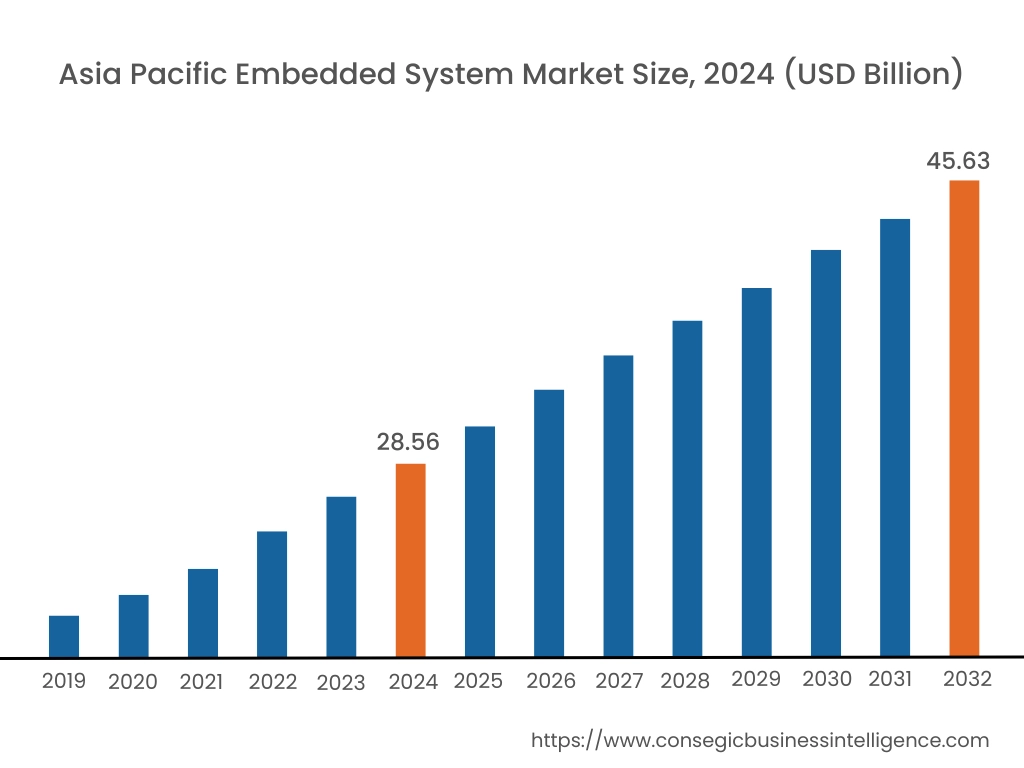
Asia Pacific region was valued at USD 28.56 Billion in 2024. Moreover, it is projected to grow by USD 29.71 Billion in 2025 and reach over USD 45.63 Billion by 2032. Out of this, China accounted for the maximum revenue share of 33.2%. As per the embedded system market analysis, the adoption of embedded devices in the Asia-Pacific region is primarily driven by growing consumer electronics, automotive, and telecommunication sectors among others. Additionally, the rising production of consumer electronic devices is further accelerating the embedded system market expansion.
- For instance, according to the India Brand Equity Foundation, the value of consumer electronics and appliances industry in India reached up to USD 9.84 billion in 2021, and it is projected to grow at a substantial rate to reach USD 21.18 billion by 2025. Therefore, the above factors are further driving the market demand in the Asia-Pacific region.
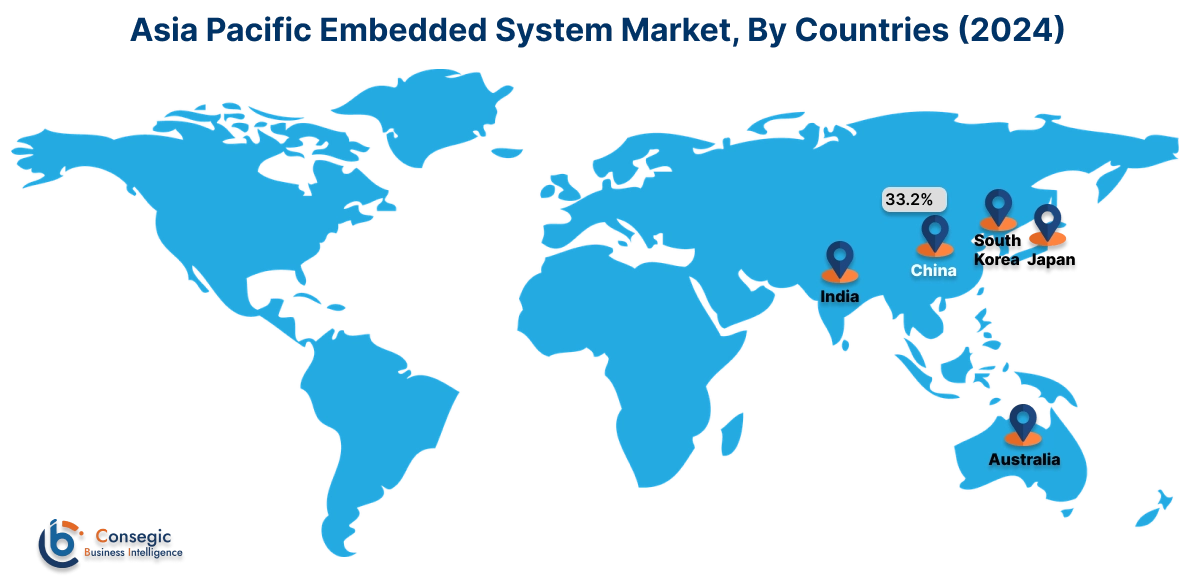
North America is estimated to reach over USD 58.28 Billion by 2032 from a value of USD 37.62 Billion in 2024 and is projected to grow by USD 39.04 Billion in 2025.
In North America, the growth of embedded system industry is driven by the growing investments in automotive, aerospace & defense, healthcare, and other industrial sectors. Moreover, the increasing production of automobiles and aircraft is contributing to the embedded system market demand.
- For instance, according to the International Organization of Motor Vehicle Manufacturers, the overall automobile production in North America reached 16.16 million in 2023, witnessing an increase of 9.3% from 14.79 million in 2022. The above factors are projected to boost the market in North America during the forecast period.
Additionally, the regional analysis depicts that the rising investments in electric vehicle manufacturing, increasing production of aircraft, and significant advancements in medical devices are driving the embedded system market demand in Europe. Furthermore, as per the market analysis, the market demand in Latin America, Middle East, and African regions is expected to grow at a considerable rate due to factors such as growing investments in aerospace & defense sector, rising consumer electronics production, and others.
Top Key Players and Market Share Insights:
The global embedded system market is highly competitive with major players providing products to the national and international markets. Key players are adopting several strategies in research and development (R&D), product innovation, and end-user launches to hold a strong position in the embedded system market. Key players in the embedded system industry include-
- Advanced Micro Devices Inc. (U.S)
- STMicroelectronics N.V. (Switzerland)
- Infineon Technologies AG (Germany)
- Analog Devices Inc. (U.S)
- Broadcom (U.S)
- NXP Semiconductors (Netherlands)
- Cisco Systems Inc. (U.S)
- Intel Corporation (U.S)
- Microchip Technology Inc. (U.S)
- Qualcomm Incorporated (U.S)
Recent Industry Developments :
Partnerships & Collaborations:
- In September 2024, AAEON partnered with The Embedded Kit, a company specializing in innovative embedded software products. The partnership aims at streamlining the development process for industrial companies by offering a completely integrated hardware and software bundle.
Acquisitions:
- In May 2024, Accenture acquired Teamexpat, a Netherlands-based embedded software specialist. The acquisition enables Accenture to utilize the company’s embedded software engineering expertise for further strengthening its smart, connected products capabilities for customers in semiconductor sector and other discrete manufacturing industries.
Embedded System Market Report Insights :
| Report Attributes | Report Details |
| Study Timeline | 2019-2032 |
| Market Size in 2032 | USD 166.42 Billion |
| CAGR (2025-2032) | 6.1% |
| By Type |
|
| By Component |
|
| By Sales Channel |
|
| By End User |
|
| By Region |
|
| Key Players |
|
| North America | U.S. Canada Mexico |
| Europe | U.K. Germany France Spain Italy Russia Benelux Rest of Europe |
| APAC | China South Korea Japan India Australia ASEAN Rest of Asia-Pacific |
| Middle East and Africa | GCC Turkey South Africa Rest of MEA |
| LATAM | Brazil Argentina Chile Rest of LATAM |
| Report Coverage |
|
Key Questions Answered in the Report
How big is the embedded system market? +
The embedded system market was valued at USD 107.46 Billion in 2024 and is projected to grow to USD 166.42 Billion by 2032.
Which is the fastest-growing region in the embedded system market? +
Asia-Pacific is the region experiencing the most rapid growth in the embedded system market.
What specific segmentation details are covered in the embedded systems report? +
The embedded systems report includes specific segmentation details for type, component, sales channel, end user, and region.
Who are the major players in the embedded system market? +
The key participants in the embedded system market are Advanced Micro Devices Inc. (U.S), STMicroelectronics N.V. (Switzerland), NXP Semiconductors (Netherlands), Cisco Systems Inc. (U.S), Intel Corporation (U.S), Microchip Technology Inc. (U.S), Qualcomm Incorporated (U.S), Infineon Technologies AG (Germany), Analog Devices Inc. (U.S), and Broadcom (U.S).
